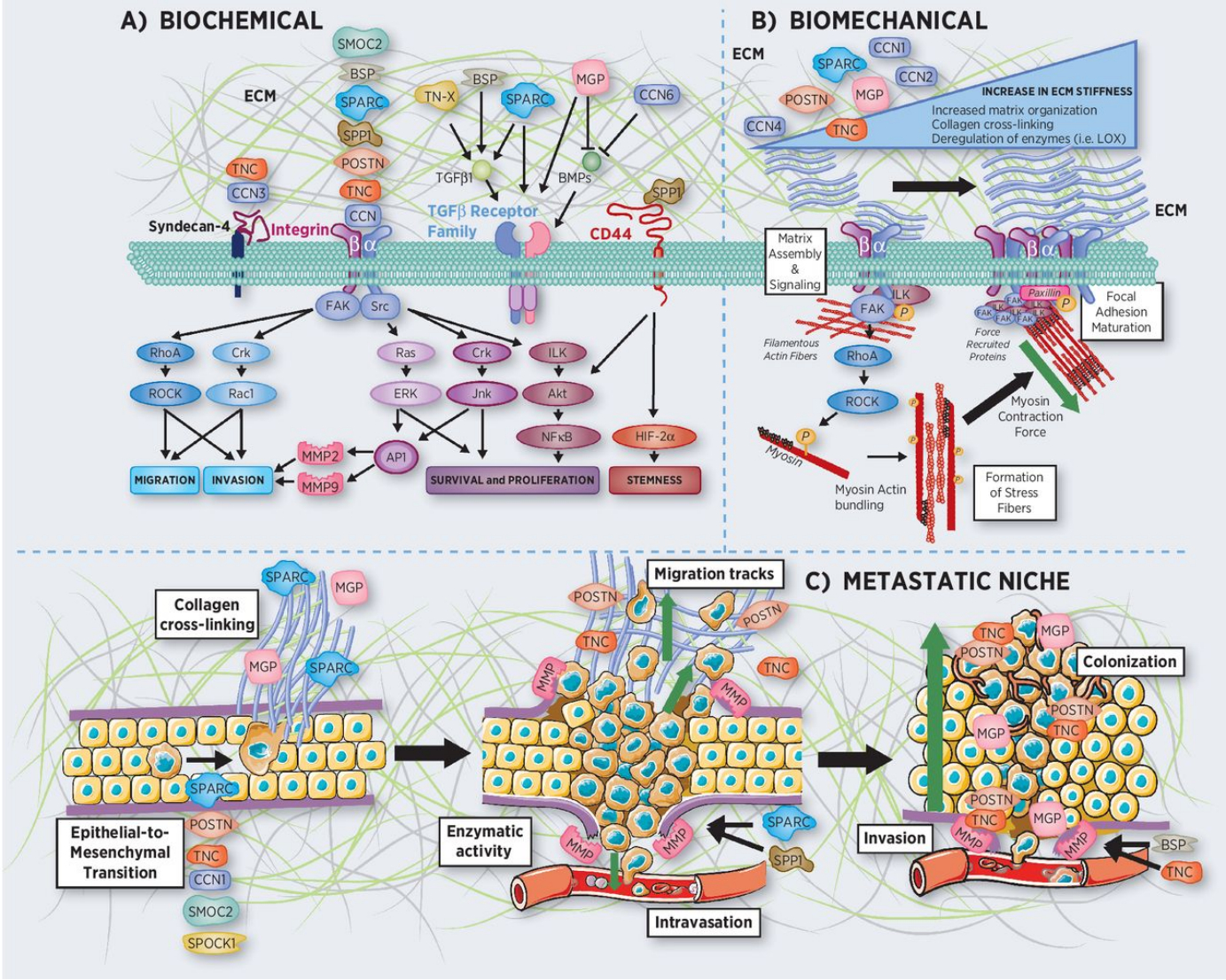Thrombospondins (TSPs) is adhesive glycoproteins classified as matricellular proteins that is originally found to be synthesised by platelets and secreted into the extracellular matrix[1, 2]. Including of THBS1, THBS2, THBS3, THBS4 and COMP[3], TSPs function as mediators in both cell-matrix and cell-cell communication, and exhibit significantly elevated expression in malignant tumor[4, 5].
Initially, attention was drawn to THBS1 for its natural anti-angiogenic effects. In recent years, this family has also been found to exert a crucial role in anti-tumor immunity, angiogenesis and EMT in tumors such as breast, gastric and liver cancer[4, 6-9]. Studies suggested that utilizing TSPs as predictors proving valuable in identifying latent malignant tumors, which might allow for the prognostication of specific patients[4, 10-12]. Notably, in various cancer types, including ovarian cancer, lung cancer, colorectal cancer, gastric cancer, and breast cancer, TSPs is correlated with shorter progression-free survival and overall survival[13].
However, while current studies have predominantly focused on the THBS1 and THBS2 molecules within the TSP family, the roles of other members in the development of colon cancer remain unclear [4, 9, 11, 14-16]. As matrix proteins display tissue-specific functions, the clinical value of the TSPs family and its function in the TME of colon cancer remains unclear, which restricts its clinical application.

References
[1] Theocharis A D, et al., Extracellular matrix structure. Adv Drug Deliv Rev, (2016):4-27. doi:10.1016/j.addr.2015.11.001
[2] Thakur R and D P Mishra, Matrix reloaded: CCN, tenascin and SIBLING group of matricellular proteins in orchestrating cancer hallmark capabilities. Pharmacol Ther, (2016):61-74. doi:10.1016/j.pharmthera.2016.09.002
[3] Incardona F, et al., Thrombospondin modulates human breast adenocarcinoma cell adhesion to human vascular endothelial cells. Cancer Res, (1995):166-73.
[4] Guo B, et al., Cartilage oligomeric matrix protein acts as a molecular biomarker in multiple cancer types. Clin Transl Oncol, (2023):535-554. doi:10.1007/s12094-022-02968-8
[5] Mccart Reed A E, et al., Thrombospondin-4 expression is activated during the stromal response to invasive breast cancer. Virchows Arch, (2013):535-45. doi:10.1007/s00428-013-1468-3
[6] Petrik J, et al., Thrombospondins in the tumor microenvironment. Semin Cell Dev Biol, (2024): 3-11. doi:10.1016/j.semcdb.2023.05.010
[7] Li Q, et al., HSCs-derived COMP drives hepatocellular carcinoma progression by activating MEK/ERK and PI3K/AKT signaling pathways. J Exp Clin Cancer Res, (2018):231. doi:10.1186/s13046-018-0908-y
[8] Kaur S and D D Roberts, Emerging functions of thrombospondin-1 in immunity. Semin Cell Dev Biol, (2024):22-31. doi:10.1016/j.semcdb.2023.05.008
[9] Carminati L, et al., Controlled extracellular proteolysis of thrombospondins. Matrix Biol, (2023): 82-100. doi:10.1016/j.matbio.2023.03.011
[10] Gordon-Weeks A and A E Yuzhalin, Cancer Extracellular Matrix Proteins Regulate Tumour Immunity. Cancers (Basel), (2020). doi:10.3390/cancers12113331
[11] Liu T T, et al., Cartilage oligomeric matrix protein is a prognostic factor and biomarker of colon cancer and promotes cell proliferation by activating the Akt pathway. J Cancer Res Clin Oncol, (2018):1049-1063. doi:10.1007/s00432-018-2626-4
[12] Wu T and G Ouyang, Matricellular proteins: multifaceted extracellular regulators in tumor dormancy. Protein Cell, (2014):249-52. doi:10.1007/s13238-014-0023-6
[13] Khorana A A, et al., Cancer-associated venous thromboembolism. Nat Rev Dis Primers, (2022). 11. doi:10.1038/s41572-022-00336-y
[14] Stenina-Adognravi O, S Muppala, and J Gajeton, Thrombospondins and remodeling of the tumor microenvironment. Vessel Plus, (2018). doi:10.20517/2574-1209.2018.40
[15] Ma H, et al., The Cancer-Associated Fibroblasts-Related Gene COMP Is a Novel Predictor for Prognosis and Immunotherapy Efficacy and Is Correlated with M2 Macrophage Infiltration in Colon Cancer. Biomolecules, (2022). doi:10.3390/biom13010062
[16] Guo Q, et al., Platelets upregulate tumor cell programmed death ligand 1 in an epidermal growth factor receptor-dependent manner in vitro. Blood Adv, (2022):5668-5675. doi:10.1182/bloodadvances.2021006120
